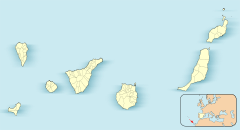 The William Herschel Telescope building | |
| Alternative names | WHT |
|---|---|
| Named after | William Herschel |
| Part of | Roque de los Muchachos Observatory |
| Location(s) | Province of Santa Cruz de Tenerife, Canary Islands, Spain |
| Coordinates | 28°45′38″N 17°52′54″W / 28.76066°N 17.88174°W |
| Organization | Isaac Newton Group of Telescopes |
| Altitude | 2,344 m (7,690 ft) |
| Built | 1983–1987 |
| First light | 1 June 1987 |
| Telescope style | reflecting telescope |
| Diameter | 4.2 m (13 ft 9 in) |
| Secondary diameter | 1.0 m (3 ft 3 in) |
| Collecting area | 13.8 m2 (149 sq ft) |
| Website | www |
| | |
The William Herschel Telescope (WHT) is a 4.20-metre (165 in) optical/near-infrared reflecting telescope located at the Roque de los Muchachos Observatory on the island of La Palma in the Canary Islands, Spain. The telescope, which is named after William Herschel, the discoverer of the planet Uranus, is part of the Isaac Newton Group of Telescopes. It is funded by research councils from the United Kingdom, the Netherlands and Spain.
At the time of construction in 1987, the WHT was the third largest single optical telescope in the world.[note 1][1][2] It is currently the second largest in Europe,[note 2] and was the last telescope constructed by Grubb Parsons in their 150-year history.
The WHT is equipped with a wide range of instruments operating over the optical and near-infrared regimes. These are used by professional astronomers to conduct a wide range of astronomical research. Astronomers using the telescope discovered the first evidence for a supermassive black hole (Sgr A*) at the centre of the Milky Way, and made the first optical observation of a gamma-ray burst. The telescope has 75% clear nights, with a median seeing of 0.7".[3]
Cite error: There are <ref group=note> tags on this page, but the references will not show without a {{reflist|group=note}} template (see the help page).
